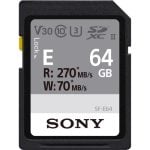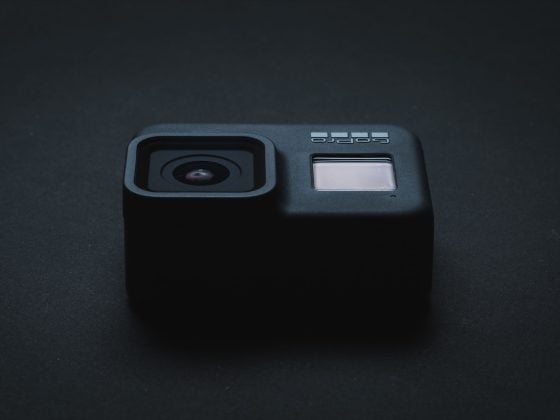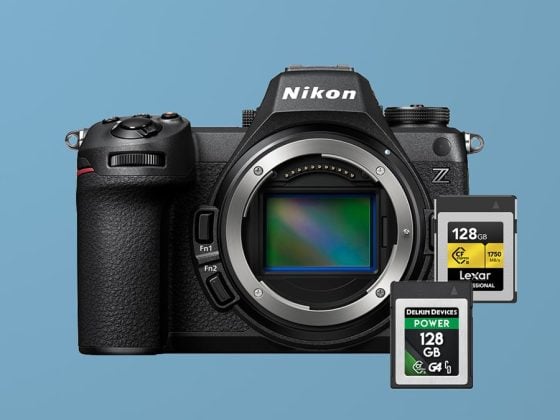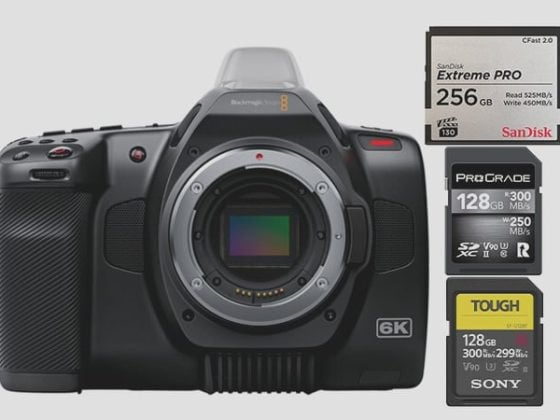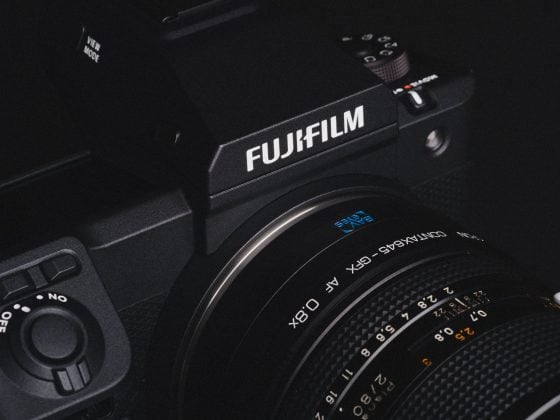The RX100 V is a camera that came out in 2016, and it has one SD card slot that supports UHS-I speed class. If you’re thinking of dusting off this old beauty to give it a new life, you might need some tips on the best memory cards. This guide will explain some of the basics and recommend the best memory cards for the Sony RX100 V.
Recommended Memory Cards Sony RX100 V
The RX100 V has one SD card slot that supports UHS-I speed class. The Sony RX100 V also had a 4k bitrate of 100Mbps, which means you need about 12.5MB/s for recording a lot of videos. You should get a card that has a U3 or V30 speed class or higher, and this will also be great for shooting photos.
The camera can handle up to a 128GB card, but you might be able to get away with larger cards as reported by some users. As a precaution, I’d recommend only a 64-128GB size memory card to prevent any compatibility problems.
These suggestions should help you find some of the best cards for this camera today.
| Recommended SD Cards | Speed Class | USB Write | USB Read | Links | |
|---|---|---|---|---|---|
| SD UHS-II V60 | UHS-II | Hide | Hide | ||
| Sony E v60 256GB | UHS-II | https://geni.us/ARfXs | Amazon / B&H | ||
| UHS-I U3 | UHS-I | Hide | Hide | ||
| Sandisk Extreme Pro 32/64/128GB | UHS-I | 144 | 172 | https://geni.us/AjId | Amazon / B&H |
| Kingston CanvasGo! 128/256/512GB | UHS-I | 124 | 161 | https://geni.us/oJU7q | B&H |
| Sony 95 | UHS-I | 81 | 90 | https://geni.us/wnX8rG | Amazon |
| Delkin Advantage 32-1TB | UHS-I | 77 | 93 | https://geni.us/HlTWWVh | Amazon / B&H |
Sony RX100 V Memory Card Speed Chart
Like the other cameras and all Sony cameras, it has a pretty bad bottleneck. It takes about a full minute to empty the buffer on most cards.
If you want to record 4k video, use U3 cards. This chart shows the benchmarks from older cards back when this camera was first released.
| SD Memory Cards | USB 3.0 Read | USB 3.0 Write | Sony RX100 V |
| UHS-II | |||
| Lexar 2000x U3 64GB | 280.9 MB/s | 181.4 MB/s | 29.57 MB/s |
| Delkin UHS-II U3 32GB | 245.1 MB/s | 164.6 MB/s | 29.34 MB/s |
| Toshiba U3 64GB | 238.5 MB/s | 199.7 MB/s | 28.88 MB/s |
| Transcend U3 64GB | 268.9 MB/s | 174.3 MB/s | 28.73 MB/s |
| Sony UHS-II U3 64GB | 253.2 MB/s | 91.62 MB/s | 28.59 MB/s |
| Lexar 1000x U3 64GB | 145.0 MB/s | 60.7 MB/s | 28.30 MB/s |
| Sandisk Extreme Pro U3 64GB | 257.3 MB/s | 109.9 MB/s | 28.20 MB/s |
| UHS-I | |||
| Samsung Pro 64GB U3 | 97.7 MB/s | 78.6 MB/s | 29.03 MB/s |
| Sandisk Extreme Pro 64GB U3 | 98.6 MB/s | 90.8 MB/s | 28.93 MB/s |
| Sandisk Extreme Plus 64GB U3 | 99.0 MB/s | 64.4 MB/s | 28.92 MB/s |
| Sandisk Extreme 64GB U3 | 72.43 MB/s | 54.1 MB/s | 28.83 MB/s |
| Kingston 64GB U3 | 98.1 MB/s | 90.4 MB/s | 28.79 MB/s |
| Samsung Pro+ 64GB U3 | 97.5 MB/s | 87.3 MB/s | 28.72 MB/s |
| Samsung Pro 64GB U1 | 96.3 MB/s | 82.2 MB/s | 28.34 MB/s |
| PNY 64GB U1 | 96.5 MB/s | 66.5 MB/s | 28.29 MB/s |
| Transcend 64GB U3 | 96.7 MB/s | 68.4 MB/s | 28.14 MB/s |
| PNY 64GB U3 | 96.5 MB/s | 66.1 MB/s | 28.11 MB/s |
| Lexar 633x 64GB U3 | 93.3 MB/s | 67.3 MB/s | 27.92 MB/s |
| Sony 64GB U3 (Old Model) | 96.5 MB/s | 84.5 MB/s | 27.85 MB/s |
| Lexar 600x 64GB U1 | 95.4 MB/s | 64.8 MB/s | 27.71 MB/s |
| Sony 64GB U3 (New Model) | 96.7 MB/s | 56.2 MB/s | 27.31 MB/s |
You can also read this guide – Memory Cards for Sony Cameras, to compare how other cameras are doing, or, see the most recent SD memory card tests.
Camera Specs
Sensor: 1″ 20.1MP / Processor: BIONZ X Image Processor
Memory Card Type: SD UHS-I
Video Max Resolution: 3840 x 2160p: 30 fps, 25 fps, 24 fps
Video Max Frame Rate: 1920 x 1080p: 250 fps, 500 fps, 1000 fps
Continuous Shooting: 71 Raw @ 41fps | 148 Jpeg @ 41fps
Memory Card Capacity: 128GB
Est. Size Of Buffer: 1.5GB
Need accessories? See the Sony RX100 IV & V Accessories Page.
Camera Write Speed Stats
(With the Sandisk Extreme Pro 64GB UHS-I SDXC U3)
Shots Taken To Fill Buffer: 71 RAW
Time Taken To Fill Buffer: 3.5secs approx.
Frames Per Second To Fill Buffer: 24fps
Frames Per Second After Buffer: 2.5 approx.
Time Taken To Clear Buffer: 47.5 seconds
Shooting 4k On The Sony RX100 V
Recording 4K video requires SDXC U3 memory cards!
If you want to shoot 4k on any Sony camera right now I recommend only using Sony brand cards like the Sony E card even though it’s a UHS-II card. A lot of people have problems with other brands, and it’s not the card’s fault, it’s the camera’s fault. One card will work fine in one camera but not in others.
Why Some Cards Don’t Work
While the RAW image shooting speed is consistent across all cards, the camera imposes restrictions when shooting 4k 100M video without a U3 SDXC card. If I format a U3 card, shoot video, and then replace it with an unformatted U1 card, the camera allows video shooting on the U1 card. However, formatting a U1 card fresh triggers a message: “Cannot record this recording setting. Either switch to a UHS-I U3 compatible memory card or change the file format.”
In essence, for simplicity, opt for a U3 card, and it must be either SDXC or SDHC to shoot XAVC S 4k video. Nevertheless, an SDHC U1 card suffices for shooting AVCHD 1080 video, albeit in a different codec and at a lower bit rate.
UHS-II Cards In The Sony RX100 V – Will They Work?
The Sony RX100 V lacks a UHS-II interface, meaning that any UHS-II card inserted into the camera will operate at UHS-I speeds. While using UHS-II cards for rapid USB 3.0 transfers is acceptable, you won’t experience any tangible advantages within the camera. Additionally, attempting to shoot 4k video on a UHS-II card might pose potential challenges.
More On The Sony RX100 V
Shoot better video with The Sony RX100 IV Video Guide.
| **This website contains affiliate links. We will earn a small commission on purchases made through these links. Some of the links used in these articles will direct you to Amazon. As an Amazon Associate, I earn from qualifying purchases. |

